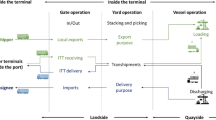Abstract
The main challenge for container ports is the planning required for berthing container ships while docked in port. Growth of containerization is creating problems for ports and container terminals as they reach their capacity limits of various resources which increasingly leads to traffic and port congestion. Good planning and management of container terminal operations reduces waiting time for liner ships. Reducing the waiting time improves the terminal’s productivity and decreases the port difficulties. Two important keys to reducing waiting time with berth allocation are determining suitable access channel depths and increasing the number of berths which in this paper are studied and analyzed as practical solutions. Simulation based analysis is the only way to understand how various resources interact with each other and how they are affected in the berthing time of ships. We used the Enterprise Dynamics software to produce simulation models due to the complexity and nature of the problems. We further present case study for berth allocation simulation of the biggest container terminal in Iran and the optimum access channel depth and the number of berths are obtained from simulation results. The results show a significant reduction in the waiting time for container ships and can be useful for major functions in operations and development of container ship terminals.
Similar content being viewed by others
References
Ali I, Abouelseoud Y, HamdyElwany M (2011). Container terminal berth allocation and quay crane assignment using IP and simulated annealing. Proceedings of the 41st International Conference on Computers & Industrial Engineering, USA, Los Angeles, 31–37.
Banks J, Carson JS (2010). Discrete event system simulation. 5th ed. Pearson Education, Inc., Upper Saddle River, NJ, 14–21.
Bierwirth Ch, Meisel F (2010). A survey of berth allocation and quay crane scheduling problems in container terminals. European Journal of Operational Research, 202(3), 615–627.
Bruzzone AG, Giribone P, Revetria R (1999). Operative requirements and advances forth new generation simulators in multimodal container terminals. Proceedings of the 31 st Conference on Winter Simulation, 2, 1243–1252. ACM Press, New York.
Cakaj Sh (2010). Modeling, simulation and optimization: focus on applications. Publisher: In Tech, India.
Dahal K, Galloway S, Hopkins I (2007). Modeling, simulation and optimization of port system management. International Journal of Agile Systems and Management, 2(1), 92–108.
Demirbilek Z, Sargent F (1999). Deep-draft coastal navigation entrance channel practice. Coastal Engineering Technical Note I-63, U.S. Army Corps of Engineers (USACE).
Economic Development Research Group (2012). Panama canal expansion study phase 1 Report: Developments in trade and national and global economies. The United States Department of Transportation, Maritime Administration, Washington, DC.
Halverson R (2009). Simulation with enterprise dynamics. Midwestern State University, Wichita Falls, TX, Journal of Computing Sciences in Colleges Archive, 21(4), 246–252
He L, Liu H, Lv H, Zhao J (2012). Optimization study of berth allocation based on genetic algorithm. ICLEM 2012: Logistics for Sustained Economic Development-Technology and Management for Efficiency, 67–73.
Hartmann S (2004). A general framework for scheduling equipment and manpower on container terminals. OR Spectrum, 26, 51–74.
Kim KH, Moon KCh (2002). Berth scheduling by simulated annealing. Transportation Research Part B, 37, 541–560.
Legato P. Mazza R (2000). Berth planning and resources optimization at a container terminal via discrete event simulation. University della Calabria, 537–547.
Meng N, Chen Y, He L (2009). Dynamic decision-making for port berth allocation. Second International Conference of Intelligent Computation Technology and Automation, 4, 188–191.
Merkuryev Y, Tolujew J, Blümel E, Novitsky L, Ginters E, Viktorova E, Merkuryeva G, Pronins J (1998). A modeling and simulation methodology for managing the Riga harbor container terminal. Simulation, 71(2), 84–95.
Nam KC, Kwak KS, Yu MS (2002). Simulation study of container terminal performance. Journal of Waterway. Port, Coastal and Ocean Engineering, 128(3), 126–132.
Perros, H (2009). Computer Simulation Techniques-The Definitive Introduction. Computer Science Department, NC State University, Raleigh.
Saanen YA (2000). Examining the potential for adapting simulation software to enable short-term tactical decision making for operational optimization. Technical Report, TBA Nederland/Delft University of Technology.
Yun WY, Choi YS (2003). Simulator for port container terminal using an object oriented approach. Working paper, Pusan National University.
Author information
Authors and Affiliations
Corresponding author
Additional information
Abdorreza Sheikholeslami was born in 1967. He received his BSc degree and MSc degree from Iran University of Science and Technology. Now he is an Associate Professor at the School of Civil Engineering, Iran University of Science and Technology. He received his Ph.D degree in Transportation Engineering and Planning from Iran University of Science and Technology in 2006. His current research interests include transportation problems.
Gholamreza Ilati was born in 1980. He is a PhD candidate at the School of Civil Engineering, Iran University of Science and Technology. His current research interests include main challenges in maritime transportation specifically berth allocation problems, bunkering, etc.
Yones Eftekhari Yeganeh was born in 1986. He received his M.S.degree in Transportation Engineering and Planning from Iran University of Science and Technology in 2011. His current research interests include dry port, port choice and marine transportation.
Rights and permissions
About this article
Cite this article
Sheikholeslami, A., Ilati, G. & Yeganeh, Y.E. Practical solutions for reducing container ships’ waiting times at ports using simulation model. J. Marine. Sci. Appl. 12, 434–444 (2013). https://doi.org/10.1007/s11804-013-1214-x
Received:
Accepted:
Published:
Issue Date:
DOI: https://doi.org/10.1007/s11804-013-1214-x




